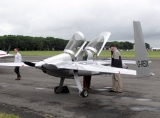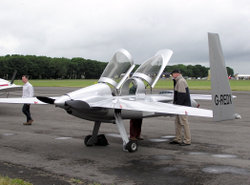
Berkut aircraft
Encyclopedia

Canard (aeronautics)
In aeronautics, canard is an airframe configuration of fixed-wing aircraft in which the forward surface is smaller than the rearward, the former being known as the "canard", while the latter is the main wing...
aircraft built primarily of carbon
Carbon
Carbon is the chemical element with symbol C and atomic number 6. As a member of group 14 on the periodic table, it is nonmetallic and tetravalent—making four electrons available to form covalent chemical bonds...
fiber and fiberglass
Fiberglass
Glass fiber is a material consisting of numerous extremely fine fibers of glass.Glassmakers throughout history have experimented with glass fibers, but mass manufacture of glass fiber was only made possible with the invention of finer machine tooling...
.
Development
The prototype Berkut was designed and built by Dave H. Ronneberg and Kerry Beresford as part of a business partnership between Ronneberg and Donald S. Murphy (called Experimental Aviation) between 1989 and 1992.In 1992 the partnership dissolved, and Ronneberg (incorporating as Experimental Aviation, Inc.) brought the aircraft to market as a kit, while Murphy wanted to shelve the project entirely. A subsequent series of lawsuits between the two resulted in bankruptcy for Ronneberg and Murphy as individuals, and for EAI as a corporation. The kit was resurrected by Renaissance Composites, in 1996, with Ronneberg working as a consultant.
In January 2001, under pressure from Ronneberg, Renaissance sold the assets to Vicki Cruse
Vicki Cruse
Vicki Cruse was an American aerobatic pilot and administrator. She won the U.S. national unlimited aerobatic title in 2007...
who then formed Berkut Engineering Inc. That company withdrew the aircraft from the market in 2002. Ronneberg continues with the project, which is now directed at UAV
Unmanned aerial vehicle
An unmanned aerial vehicle , also known as a unmanned aircraft system , remotely piloted aircraft or unmanned aircraft, is a machine which functions either by the remote control of a navigator or pilot or autonomously, that is, as a self-directing entity...
markets. In 2003 a deal was struck to sell the project to Republic Aerospace but the deal fell through. Cruse was no longer involved with day-to-day operations, but maintained ownership, until her death on August 22, 2009, when her plane crashed in Britain.
Through the various incarnations approximately 75 kits were sold, and 20 airplanes completed.
Configuration
The Berkut is descended from the Rutan Long-EZRutan Long-EZ
-See also:-External links:****...
, with the primary differences being retractable main landing gear
Landing Gear
Landing Gear is Devin the Dude's fifth studio album. It was released on October 7, 2008. It was his first studio album since signing with the label Razor & Tie. It features a high-profile guest appearance from Snoop Dogg. As of October 30, 2008, the album has sold 18,906 copies.-Track...
, dual canopies, and molded fuselage
Fuselage
The fuselage is an aircraft's main body section that holds crew and passengers or cargo. In single-engine aircraft it will usually contain an engine, although in some amphibious aircraft the single engine is mounted on a pylon attached to the fuselage which in turn is used as a floating hull...
, strakes, and spar. Like the Long EZ, the Berkut carries 2 people in tandem seats. The front seat occupant has access to all instrumentation and controls. The rear seat, normally holding the passenger, is equipped with a side stick and throttle, but no rudder pedals, brakes, or instruments. Aerodynamically only minor changes were made. The fuselage was stretched, and the nose, canard, instrument panel and pilot moved forward one foot, to allow a heavier engine to be used in the back. The main wing
Wing
A wing is an appendage with a surface that produces lift for flight or propulsion through the atmosphere, or through another gaseous or liquid fluid...
trailing edge
Trailing edge
The trailing edge of an aerodynamic surface such as a wing is its rear edge, where the airflow separated by the leading edge rejoins. Essential control surfaces are attached here to redirect the air flow and exert a controlling force by changing its momentum...
was straightened, removing a small bend in the trailing edge of the Long EZ wing. The lower winglet was removed and the aileron
Aileron
Ailerons are hinged flight control surfaces attached to the trailing edge of the wing of a fixed-wing aircraft. The ailerons are used to control the aircraft in roll, which results in a change in heading due to the tilting of the lift vector...
size increased in both chord and span, increasing roll rate.
Early Berkuts used wings and canard that were structurally similar to the Long-EZ and used hot-wired solid blue 2 lb/cu. ft. density Dow STYROFOAM PI cores, but with carbon fiber
Carbon fiber
Carbon fiber, alternatively graphite fiber, carbon graphite or CF, is a material consisting of fibers about 5–10 μm in diameter and composed mostly of carbon atoms. The carbon atoms are bonded together in crystals that are more or less aligned parallel to the long axis of the fiber...
skins instead of fiberglass. The fuselage and winglets remained fiberglass. Later versions (kits produced after spring 1999) used fully molded carbon fiber canards and wings with high density, 5 lb/cu. ft. 1/4" thick PVC or SAN foam cores, leaving only minor fairings and tip surfaces to be carved from foam. The Berkut has always used the Roncz 1145MS canard airfoil, which is more tolerant of bug and rain contamination than the original GU 25-5(11)8 airfoil originally used on the Long-EZ.
Berkuts used a retractable main (rear) landing gear system designed by Shirl Dickey for his E-Racer homebuilt. Originally Berkut used gear parts produced by Dickey, but over time they were repeatedly re-engineered and strengthened. Later kits had gear components produced entirely in-house. Like the earlier Vari-Eze and Long EZ, the Berkut parks with its nose gear retracted to prevent the plane from tipping over backwards when parked without a pilot in the front seat. Some early Berkuts utilized hydraulic nose-gear extension systems, but most have used an electro-mechanical jack-screw. With the electric system the pilot can climb into the cockpit with the nose down, then extend the nose gear, raising the airplane with him inside.
While the Long-EZ was closer in the design of the Berkut it was originally designed for the Lycoming O-235
Lycoming O-235
The Lycoming O-235 is a family of four-cylinder, air-cooled, horizontally opposed piston aircraft engines that produce , derived from the earlier O-233 engine....
108-118 hp engine, the Berkut was designed from the outset for the larger Lycoming IO-360 180 hp engine. The aircraft was later adapted (with a different engine mount, cowls and battery location) to accept the 260-hp Lycoming IO-540
Lycoming O-540
|-Specifications :-See also:-External links:...
, which most builders chose. With the 540, some have reportedly reached speeds of 300 mph in level flight.
Selected accidents
The Berkut has a poor safety record, with about a quarter of all completed airplanes crashing at some point. However, there is no single cause which has resulted in more than one crash. Each crash has been the result of construction error or pilot error.N91DR. The original prototype, crashed by Rick Fessenden at an airshow at Santa Paula, California. Although the NTSB investigation concluded that an accelerated stall during Fessenden's "wind up turn" - a level 360-degree very high-G turn - caused the airplane to crash, examination of videotapes of the crash gave a strong indication that the pilot blacked out under 9+ Gs. Fessenden was killed.
N260DG. The first Berkut 540, built by Dan Gray, also crashed at Santa Paula. Gray started and finished his first flight at nearby Camirillo airport but on his second flight he chose to return to Santa Paula. On final approach his engine stopped and, in attempting to set down on a nearby freeway, he collided head-on with a Honda station wagon. The aircraft was extensively damaged but Gray was only bruised. The cause was found to be an incorrectly rebuilt fuel pump.
N600SE. Built by Michael Kasyan, this airplane served as the company demonstrator for several years. While being flown by another pilot, the plane encountered a dust devil on final approach. This flipped the airplane upside down and it tumbled down the runway. Both wings were broken, the right strake and spar were broken halfway between the fuselage and the end of the spar, the main gear was torn out, and the nose crushed back to the instrument panel. The pilot's legs were broken but the passenger suffered only a minor cut to the scalp. The airplane was rebuilt and is flying again.
N538AJ. This airplane, owned by John Daniels, has had several accidents, all involving the landing gear. The NTSB report concerns its first, a gear collapse at Jackson Hole, Wyoming. Later the airplane overran the runway at First Flight airport, tearing out its gear legs. There have been no injuries from any of the accidents.
N287CM. Built by Steve Drybread. During a test flight Drybread left out the main canard attach bolts. The canard separated in flight, Drybread was killed.
N5439N. Built by Steve Drybread. While being flown by its owner, Charles Bracken, the aircraft struck high tension power wires and crashed into the ground. The airplane was destroyed, the nose crushed back to the pilot's seat. Bracken's legs were broken.
Variants
- Berkut 360 - Original configuration, retractable gear, Lycoming 4 cylinder 360 cubic inch, fuel injected, 180 hp engine.
- Berkut FG360 - Fixed-gear version of the 360. (Offered but never built, except as a UAV by Geneva Aerospace )
- Berkut 540 - Lycoming 6 cylinder, 540 cubic inch, 260 hp engine upgrade. Changes consisted of larger cowls, a different engine mount, custom engine mount ears, stiffer engine isolators, a custom sump modification and different cooling baffles.
- Berkut FG540 - Fixed-gear version of the 540. (Offered but never built)
- Mobius - a modified Berkut with a single canopy and automated flight equipment located where the second seat would be located, for UAV research and development. Two aircraft have been built with a third one in development. N442LT is the first tail number. N497LT is the second.
- Berkut Jet - a Berkut using a modified GE T-58 turbine engine, built by Jerrold Jorritsma. Crashed in Loveland, CO on May 9, 2010
Specifications
See also
- Rutan Long-EZRutan Long-EZ-See also:-External links:****...
- Rutan VariEzeRutan VariEze-See also:-References:* "Flying the VariEze", Air Progress, April 1978.* * * * Taylor, John W. R. Jane's All The World's Aircraft 1982–83. London:Jane's Yearbooks, 1982. ISBN 0-7106-0748-2.* * Flight International 1976...
- Rutan DefiantRutan Defiant|-References:*...
- Steve Wright Stagger-EzSteve Wright Stagger-EzStagger-Ez is a three place pusher canard aircraft, featuring staggered seating, a dihedral canard, and rounder fuselage differences from other canard aircraft in its class . It was designed by Steve Wright.-See also:...
- Cozy MK IVCozy MK IVThe Cozy Mark IV is a 4-seat, single engine, homebuilt light aircraft designed by Nat Puffer. The aircraft is built from plans using basic raw materials. It is not a kit aircraft, though many small parts are available prefabricated. The Cozy is similar in design and construction to the 2-seat Rutan...
- Velocity SEVelocity SEThe Velocity SE is the entry level canard pusher aircraft from Velocity Aircraft.The four seat, rear engine aircraft may be powered by a Lycoming IO-320 or a Lycoming IO-360 engine.- See also :* Velocity XL* Rutan Long-EZ...
- Velocity XLVelocity XLThe Velocity XL is the eXtra Large version of the canard pusher aircraft from Velocity, Inc..-Standard propeller-driven XL:The standard Velocity XL is available in 4 seat or 5 seat configurations. Powered by either a Lycoming , IO-540 engine or a Teledyne Continental IO-550, the XL offers a...
External links
- James Redmon, who built Berkut serial number 013 (N97TX), maintains a website http://www.berkut13.com/berkut.htm documenting his experience building and flying the plane. Mr Redmon has since been hired as a test pilot for Berkut Engineering.
- Flight test of the aircraft, and photographs
- Archived page of the manufacturer
- http://beanddi.com/
- http://www.l-3com.com/uas/tech_uas/mobius.htm

